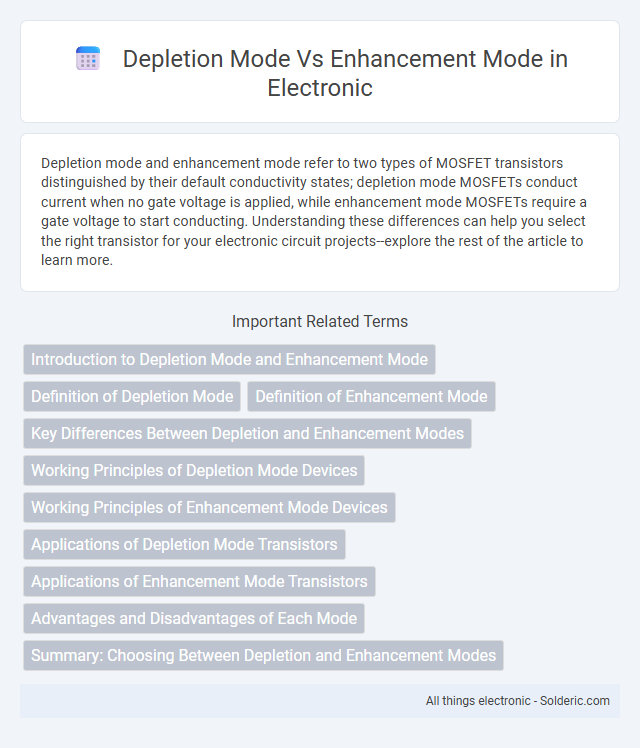Depletion mode and enhancement mode refer to two types of MOSFET transistors distinguished by their default conductivity states; depletion mode MOSFETs conduct current when no gate voltage is applied, while enhancement mode MOSFETs require a gate voltage to start conducting. Understanding these differences can help you select the right transistor for your electronic circuit projects--explore the rest of the article to learn more.
Comparison Table
| Feature | Depletion Mode | Enhancement Mode |
|---|---|---|
| Operation | Normally ON at zero gate voltage | Normally OFF at zero gate voltage |
| Gate Voltage Effect | Applying negative gate voltage reduces current (depletes channel) | Applying positive gate voltage increases current (enhances channel) |
| Channel Type | Existing channel by default | No channel at zero gate voltage |
| Use in Circuits | Used for load resistors and constant current sources | Used as switches and amplifiers |
| Symbol | Solid line for channel | Broken line for channel |
| Typical Devices | Depletion-mode MOSFETs, JFETs | Enhancement-mode MOSFETs |
Introduction to Depletion Mode and Enhancement Mode
Depletion mode and enhancement mode are two fundamental operating modes of field-effect transistors (FETs), particularly in MOSFET technology. Depletion mode FETs operate with a conductive channel at zero gate-to-source voltage, and applying a voltage depletes carriers to control conductivity, while enhancement mode FETs require a gate voltage to induce a conductive channel. Understanding these modes is essential for designing digital and analog circuits, as they determine transistor behavior, switching characteristics, and power efficiency.
Definition of Depletion Mode
Depletion mode refers to a type of transistor operation where the device is normally on, allowing current to flow without any gate voltage applied. Applying a negative gate voltage reduces the channel conductivity, thereby depleting charge carriers and decreasing current flow. This contrasts with enhancement mode, which requires a positive gate voltage to induce a conductive channel in an initially off transistor.
Definition of Enhancement Mode
Enhancement mode refers to a type of transistor operation where the device remains normally off and requires a positive gate-to-source voltage for NMOS or a negative voltage for PMOS to create a conductive channel. In this mode, no current flows when the gate voltage is zero, making the transistor ideal for switching applications that demand low power consumption in its off state. Enhancement mode transistors are widely used in CMOS technology to improve energy efficiency and circuit reliability.
Key Differences Between Depletion and Enhancement Modes
Depletion mode MOSFETs conduct current when the gate-to-source voltage is zero and require a negative gate voltage to turn off, while enhancement mode MOSFETs remain off at zero gate voltage and need a positive gate voltage to conduct. The threshold voltage in depletion mode is typically negative, enabling normally-on operation, whereas enhancement mode devices have a positive threshold voltage, resulting in normally-off behavior. Understanding these differences helps you select the appropriate transistor for switching applications based on whether you need normally-on or normally-off characteristics.
Working Principles of Depletion Mode Devices
Depletion mode devices operate by using a built-in channel that allows current to flow when no gate voltage is applied, and applying a voltage to the gate depletes the channel of charge carriers to reduce or stop conduction. Unlike enhancement mode devices that require a positive gate voltage to create a conductive channel, depletion mode transistors are normally on, turning off when a reverse gate voltage is applied. Understanding the working principles of depletion mode devices helps optimize your circuit design for applications requiring normally-on switching characteristics.
Working Principles of Enhancement Mode Devices
Enhancement mode devices operate by applying a gate voltage that induces a conductive channel in an initially non-conductive semiconductor region, enabling current flow between the source and drain terminals. When a positive voltage is applied to the gate of an n-channel MOSFET, it attracts electrons toward the gate oxide interface, forming an inversion layer that acts as a channel. This gate-controlled channel modulation allows precise control of the device's conductivity, making enhancement mode transistors ideal for digital switching applications.
Applications of Depletion Mode Transistors
Depletion mode transistors are commonly used in applications requiring normally-on switching behavior, such as in analog circuits, voltage regulators, and current sources, due to their ability to conduct current without gate voltage. They play a crucial role in load resistors, switching circuits, and as constant current devices in amplifier circuits. Your choice of depletion mode transistors benefits circuits where fail-safe or default conduction is essential for operation.
Applications of Enhancement Mode Transistors
Enhancement mode transistors are widely used in digital circuits, especially as the fundamental building blocks in CMOS technology, enabling energy-efficient and high-speed switching. They play a crucial role in microprocessors, memory devices, and power management circuits due to their normally off state, which reduces power consumption when inactive. Your electronic designs benefit from enhancement mode transistors by achieving better control over switching behavior, allowing for improved device performance and reliability in various applications.
Advantages and Disadvantages of Each Mode
Depletion mode MOSFETs offer the advantage of normally-on operation, enabling fail-safe circuits with low static power consumption but can lead to higher standby losses and complexity in switching control. Enhancement mode MOSFETs are normally-off devices providing better control, lower leakage current, and improved power efficiency in digital circuits, though they require a gate voltage to turn on, which may increase drive complexity and switching delay. Selection between depletion and enhancement modes depends on application requirements such as power efficiency, control complexity, and fail-safe behavior.
Summary: Choosing Between Depletion and Enhancement Modes
Depletion mode transistors conduct current at zero gate voltage and require a negative gate voltage to turn off, making them ideal for fail-safe circuits. Enhancement mode transistors remain off at zero gate voltage and need a positive gate voltage to conduct, providing better control and efficiency in switching applications. Selecting between depletion and enhancement modes depends on the specific requirements of fail-safe operation versus controlled switching in electronic designs.
depletion mode vs enhancement mode Infographic

 solderic.com
solderic.com